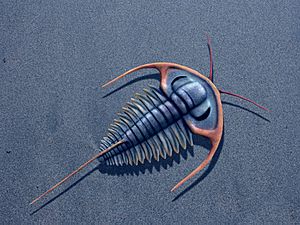Eoredlichia facts for kids
Quick facts for kids Eoredlichia |
|
|---|---|
 |
|
| Eoredlichia intermedia, collected near Chengjiang (Yunnan) | |
| Scientific classification |
|
| Kingdom: | Animalia |
| Phylum: | Arthropoda |
| Class: | †Trilobita |
| Order: | †Redlichiida |
| Family: | †Redlichiidae |
| Subfamily: | †Pararedlichiinae |
| Genus: | †Eoredlichia Chang, 1950 |
| Type species | |
| E. intermedia (Lu, 1940)
|
|
| Synonyms | |
|
|
Eoredlichia was an extinct type of trilobite. Trilobites were ancient sea creatures that lived long ago. This one could grow quite large, up to 12 centimetres (4.7 in) long. If you included its long tail spine, it could be as long as 20 centimetres (7.9 in)!
It lived a very long time ago, during the early Cambrian period. Its fossils have been found in China, Australia, and Thailand. The name Eoredlichia means "early Redlichia". This is because it is an older relative of another trilobite called Redlichia. The second part of its name, intermedia, means "intermediate". This shows it had features that were in between other species.
What Eoredlichia Looked Like
Like most early trilobites, Eoredlichia was very flat. Its body was not very thick or heavy. It had special eye ridges that looked like sickles.
The Head Shield (Cephalon)
The head part of Eoredlichia is called the cephalon. It was about twice as wide as it was long. It had a pointed shape at the back where two long spines grew out. These spines are called genal spines. They started pointing outwards and then curved backwards.
The central area of the head is called the glabella. It got narrower towards the front. It also had three lines or grooves crossing it.
The Body (Thorax)
The middle part of the trilobite's body is called the thorax. Eoredlichia had fifteen segments in its thorax. One of these segments, the ninth one from the front, had a very long spine. This spine could be as long as the rest of the trilobite's body!
Legs and Gills
Eoredlichia is special because scientists have found fossils showing its legs and gills. These are called biramous appendages. They also found its gut, which is its digestive system.
The antennae were thin and whip-like. They were about one-third the length of its body. Each antenna had many small rings, and each ring had a tiny hair.
Like other adult trilobites, Eoredlichia had legs and gills. It had 21 pairs of these. The base of each leg, called the coxa, had spines. Scientists think these spines helped it chew food.
Each leg had seven segments. The last segment was forked, like a claw. This claw probably helped the trilobite grip the seafloor. The gills were long and thin filaments. They likely helped the trilobite breathe underwater.
Eoredlichia had three pairs of legs under its head. It had one pair of legs under each of its fifteen body segments. It also had three tiny pairs of legs under its tail.
The gut of Eoredlichia was a straight tube. It had nine pairs of small sacs, called diverticulae. Four of these were in the head and five were in the body. Scientists believe Eoredlichia was a scavenger or a predator. This means it likely ate dead things or hunted other small creatures.


